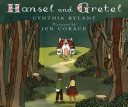
A retelling of the well-known tale in which two children lost in the woods find their way home despite an encounter with a wicked witch who wants to eat them.
- ISBN: 9781423111863
- Authors: Brothers Grimm; Rylant, Cynthia
- Illustrator: Corace, Jen
- Published: 2008 , Hyperion Book CH
- Themes: abandonment, Brother and sister, cleverness, forest, Witches
- Descriptors: Europe, Folklore and Fairy Tales, Germany, Picture Book, Primary (ages 6-9)
- No. of pages: 40

Hansel and Gretel, originally written by the Brothers Grimm and retold by Cynthia Rylant, is a magical fairytale that can be enjoyed by children of all ages. This well-known tale is about a brother and sister who get lost in the woods and end up at the home of a wicked witch, who wants nothing more than to eat the poor, innocent children.
There are many different versions of this famous fairytale available in print, all varying in different ways, from the details of the story, to the style of the author’s writing. This particular version of Hansel and Gretel brings out a somewhat darker, scarier storyline than many of the others that I have read. In this book, Rylant touches upon themes such as: religion, poverty, death, sickness, starvation, child abandonment, and murder. In comparison to many of the other versions of Hansel and Gretel that I have read, this story has a much more sinister tone that could frighten young children.
Even though this story may be somewhat scary when compared to other versions of the same tale, I could see this book being used as a valuable resource during my class’s fairytale unit. This year, the students in my third grade class will be studying fairytales as a reading unit, and one of the objectives for this unit is for students to compare and contrast different books that tell the same story. By reading Rylant’s version of Hansel and Gretel, along with a few other versions of the same story, students should be able to notice and identify differences and similarities across stories. This book, along with other copies of the story, provides students with an excellent opportunity to learn about and study intertextuality.
In my opinion, this is a wonderful book to share with students in grades 3-6. This book tells the story of a classic fairytale that most students will probably already be familiar with, and the illustrations (by Jen Corace) are absolutely stunning. I recommend this book to all teachers of students in the middle to upper elementary grades.